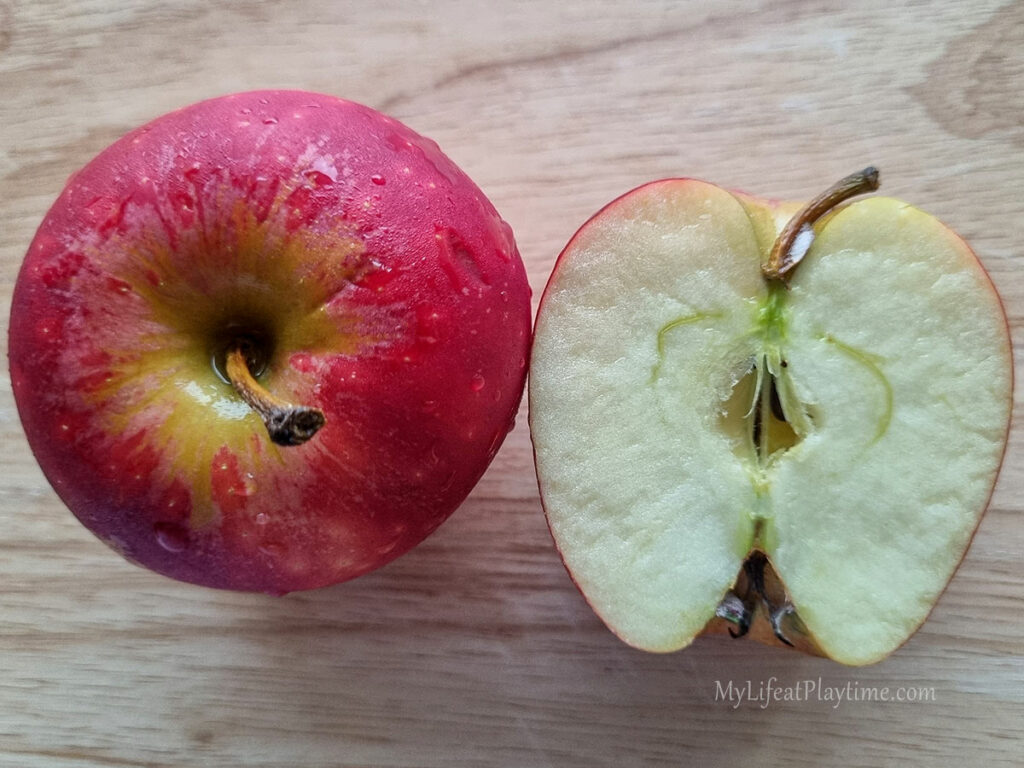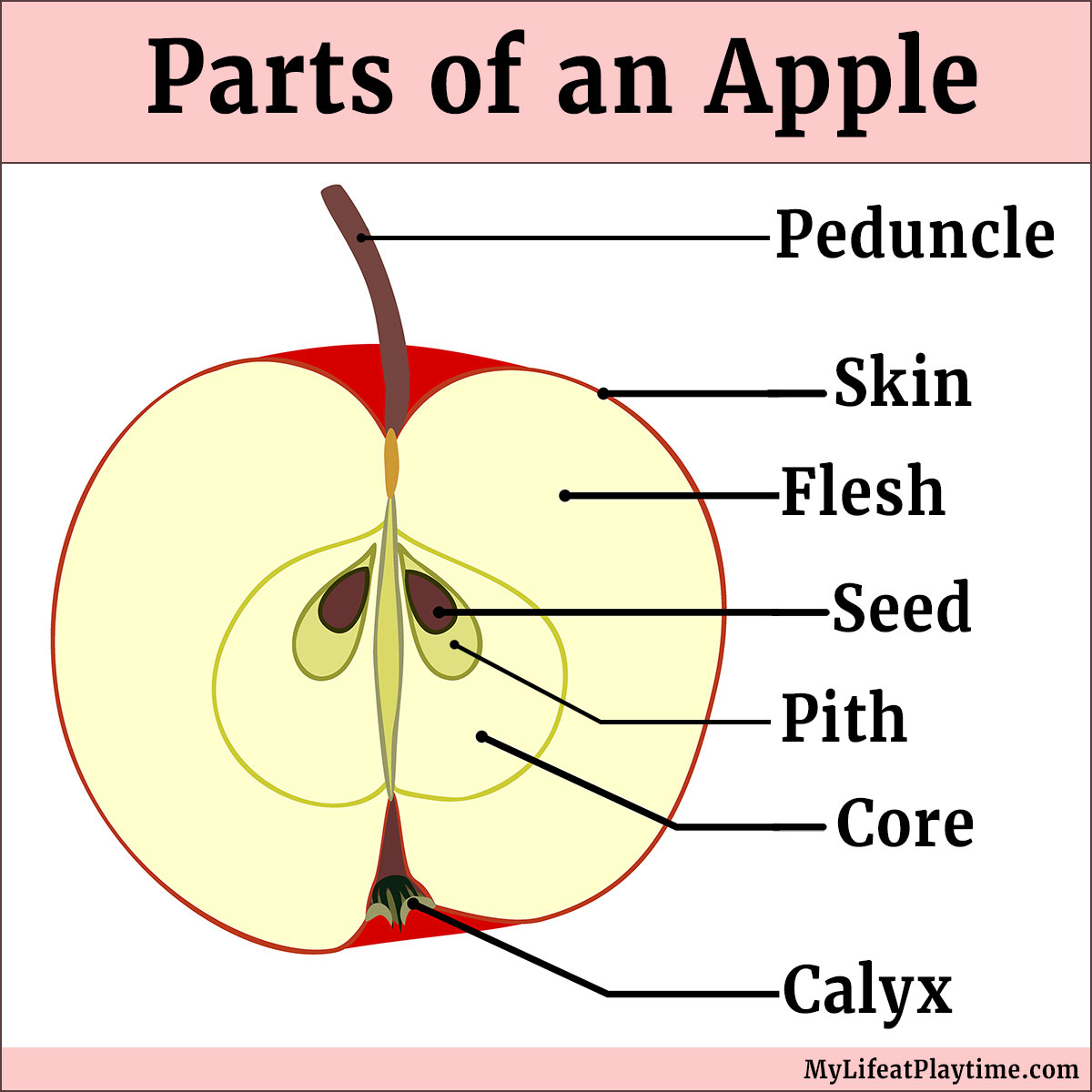Have you ever held an apple in your hand and wondered what makes up this delicious fruit? Well, my daughter, Emma, had the same question!

While apples come in many different shapes, sizes, and colors – from vibrant reds to sunny yellows and refreshing greens – they all share the same basic parts.
Every apple, whether tart or sweet, consists of at least seven interesting parts, each playing its own role in shaping the fruit. Ready to uncover these elements and the secrets they hold?
Let’s dive in!
Anatomy of an Apple

1. Peduncle (Stem)
Apples grow on trees, and they need a part that helps them hang from the tree branches. That part is the stem, also known as the ‘peduncle.’
Emma was surprised when I told her that technically, the stem can be eaten. Then she asked me, ‘Mommy, why do you throw away the peduncle when you give me an apple?’
I explained that while it’s not harmful, the stem doesn’t have a pleasant taste or texture, which is why we usually discard it.
2. Skin or Peel
The skin, or peel, is like the apple’s protective layer. It keeps the fruit inside safe from harm.
I told Emma that it’s like our skin, which helps protect us from things that might harm our bodies. The skin of an apple can be yellow, red, or green depending on the type of apple.
What’s really special about the skin is that it’s full of good stuff our bodies love! Just like we get strong and healthy by eating our vegetables, the skin of the apple has lots of nutrients that help us grow and stay healthy.
So, even though some people prefer peeling it off, eating the skin of the apple can make you stronger and healthier.
3. Flesh
Emma let out a gasp as I told her that the apple had flesh under its skin. She was confused because she thought only humans and animals had flesh. I explained that this is the white part of the apple that everyone eats.
It is juicy, sweet, and has many healthy nutrients. When people say they are eating an apple, it is the flesh they are talking about. Kids should have this item for growing and gaining energy.
4. Seeds
All apples have seeds inside them. These are the small, brown pieces found in the middle of the apple, nested within the core. Some apples may have as few as five seeds, while others might contain more than ten.
Emma looked at me with curiosity in her eyes and asked, ‘Mommy, can we eat the seeds in an apple?’ I shook my head and explained to her why it’s better not to.
‘Although apple seeds are small, they contain a substance called amygdalin,’ I told her.
When our bodies process amygdalin, it can release a small amount of cyanide, which is a toxic substance. While accidentally eating an apple seed or two won’t harm you, it’s still better to avoid eating them just to be safe.’
Seeds play a very special role in the life of an apple tree. ‘Do you remember how we planted a seed in the garden and watched it grow?’ I asked Emma. ‘The seeds in an apple can do the same thing! If planted and cared for properly, an apple seed can grow into a whole new apple tree.’
Emma’s eyes lit up at the thought. She looked at the apple seeds with newfound respect and declared that she wanted to plant one. We decided to keep some aside for our next gardening adventure.
5. Core
The core is the middle part of an apple. It is visible when the apple is cut in half. You can also identify it easily, I cut an apple in front of Emma, and she easily identified the core.
When you cut an apple in half across the middle, the core forms a star-like pattern. Inside this part of the apple, you’ll find the seeds nestled in small compartments.
Each seed is surrounded by a layer of protective tissue, which is called the ‘pith’. Although some people choose to eat the entire apple, including the core, many find it less appealing due to its tougher texture.
Additionally, as the core contains seeds that can release small amounts of cyanide when digested, it’s generally advised to avoid eating this part.
The seeds can be removed by hand. After that, you can eat away the central part to enjoy the tasty apple. However, compared to the surrounding flesh, the core can be slightly hard to chew.
6. Pith
As I explained above, the pith is a special part of an apple that you can find inside the core.
If you look closely at the apple seeds, you’ll see they are each surrounded by a layer of protective tissue. This is the ‘pith.’ It acts like a cushion for the seeds, helping to keep them safe until they are ready to grow into new apple trees.
While the pith is not as tasty as the flesh and can be harder to chew, it’s an important part of the apple’s life cycle.
7. Calyx
This is the last part of an apple and forms its bottom. It is always on the opposite side of the stem. An apple grows as a blossom with petals and sepals like flowers. ‘Sepals’ are like the little green leaves you see at the base of a flower bud, protecting it before it opens.
The Calyx are the remaining parts of sepals once the apple has been picked off from a tree. Thin threads can be seen coming out of this part.
Fun Facts about Apple
Have you ever wondered why apples come in so many different colors? It’s like they each have their own wardrobe!
This is all thanks to something called ‘pigments’. These pigments give apples their lovely red, green, or yellow skins.
- Red apples get their color from a pigment known as ‘anthocyanin’.
- Green apples are full of ‘chlorophyll’, the same substance that gives leaves their green color.
- And yellow apples? They have something called ‘carotenoids’.
Isn’t it fascinating how nature dresses apples in different colors?
Also see: Parts of a Mushroom
Closing Thoughts
Isn’t it amazing how much there is to discover about something as simple as an apple? They’re not only tasty and packed with nutrients but also offer us a fascinating glimpse into the world of nature.
Emma was thrilled to learn about the different parts of an apple and is eager to explore other fruits. I bet your little explorers would also enjoy this fun learning journey.
So next time when they bite into an apple, remind them of the wonder they hold in their hands. Keep fostering their curiosity, and who knows? We might have future botanists and nutritionists among us!
Until next time, keep exploring and stay curious.